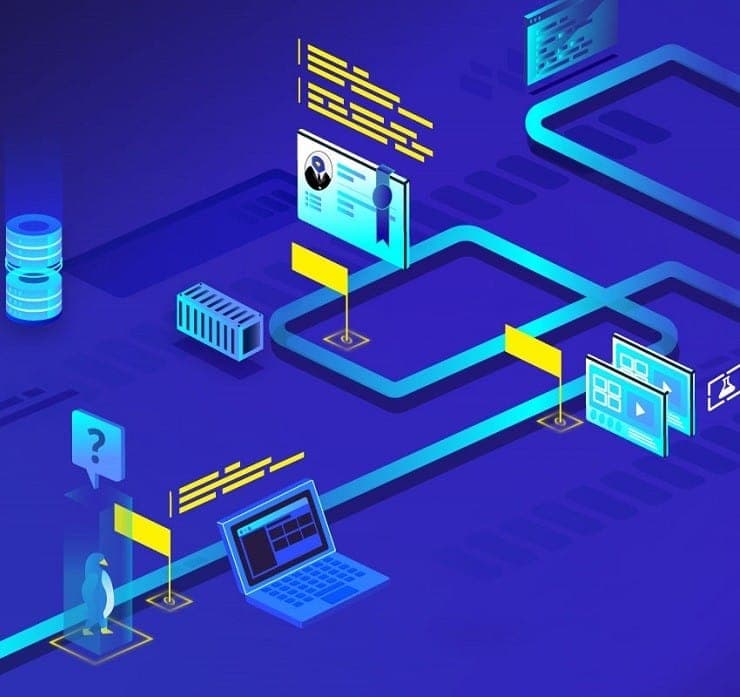Student Feedback
TK0-201: CompTIA CTT+ Essentials Certification Video Training Course Outline
Course Introduction
Planning Prior to the Course (Do...
Methods & Media for Instruct...
Instructor Credibility & Com...
Group Facilitation (Domain 4)
Evaluating the Training Event (D...
Classroom Instruction Performanc...
Virtual Classroom Performance Ba...
Course Introduction
TK0-201: CompTIA CTT+ Essentials Certification Video Training Course Info
CompTIA CTT+ Essentials TK0-201 Practice Course with Real Exam Simulations
Boost your preparation with over 450 CTT+ questions designed to keep your study sessions sharp, efficient, and stress-free.
Description
The CompTIA CTT+ Essentials (TK0-201) Practice Test is a comprehensive training resource designed to help learners prepare thoroughly for the CompTIA Certified Technical Trainer certification exam. This course focuses on providing over 450 practice questions that accurately reflect the exam’s difficulty level and structure. Each question is developed to challenge critical thinking, assess practical knowledge, and enhance the ability to apply training concepts in real-world instructional environments. By using this course, students and professionals can build confidence, improve their instructional delivery skills, and increase their chances of passing the TK0-201 exam on the first attempt. The CompTIA CTT+ credential validates essential competencies for trainers and educators, ensuring they can design, deliver, and evaluate effective training sessions across multiple learning settings. Whether you are an aspiring instructor, corporate trainer, or experienced educator, this practice test offers the preparation needed to excel in every domain of the CTT+ exam and advance in the field of professional training.
What You Will Learn From This Course
• Gain in-depth knowledge of all CompTIA CTT+ Essentials TK0-201 exam domains
• Develop strong instructional planning and course preparation skills
• Improve instructional delivery methods to engage diverse audiences
• Strengthen communication techniques to establish instructor credibility
• Learn to manage group interactions and classroom dynamics effectively
• Apply evaluation techniques to measure training success and recommend improvements
• Practice with 450+ realistic questions to identify strengths and areas for improvement
• Build confidence to pass the CompTIA CTT+ exam on the first attempt
Learning Objectives
• Understand the structure and key concepts of the CTT+ TK0-201 exam
• Master strategies for planning courses and aligning objectives with training materials
• Select appropriate instructional methods and media for effective delivery
• Demonstrate strong communication and facilitation skills during training sessions
• Evaluate training effectiveness and make recommendations for continuous improvement
• Apply scenario-based reasoning to handle real-world instructional challenges
• Use exam simulations to become familiar with question formats and time constraints
Target Audience
• Aspiring professional trainers who want to achieve CompTIA CTT+ certification
• Corporate trainers seeking to validate their teaching and delivery skills
• IT professionals transitioning into training or instructional roles
• Educators and teachers aiming to strengthen technical training competencies
• Instructional designers interested in improving course planning and delivery strategies
• Job seekers who want to showcase advanced instructional skills for career growth
• Employers and managers who wish to upskill teams in training methodology
Requirements
To succeed in this course, learners should have a strong interest in instructional delivery, teaching, or training in professional environments. Familiarity with basic training concepts or prior experience in presenting information to groups will be helpful but not required. A commitment to consistent practice and review of exam-style questions will significantly increase the chances of achieving a high score on the CompTIA CTT+ Essentials exam.
Prerequisites
• Basic understanding of training or classroom instruction principles is recommended
• Access to a computer or mobile device with a stable internet connection for online practice
• Willingness to dedicate time to review explanations and refine instructional techniques
• Motivation to pursue a globally recognized CompTIA CTT+ certification for career advancement
Course Overview
The CompTIA CTT+ Essentials (TK0-201) Practice Test is structured to replicate the actual exam experience, giving learners the tools to succeed through comprehensive question sets and detailed explanations. The exam is designed to evaluate essential trainer skills such as planning before the course, selecting instructional methods, demonstrating instructor credibility, facilitating group participation, and evaluating the training event. Each of these domains is represented in the practice questions, allowing learners to develop a balanced skill set that meets the expectations of professional trainers.
Planning before the course involves analyzing learner needs, defining objectives, and preparing training materials that align with learning goals. This domain teaches learners to create structured plans that ensure each session meets educational requirements. Methods and media for instructional delivery focus on selecting the most effective teaching techniques, incorporating technology, and adapting to different learning styles to enhance engagement and retention. Instructor credibility and communication emphasize building trust, maintaining professionalism, and using clear communication strategies to connect with participants. Group facilitation, the largest domain, trains learners to manage interactions, encourage participation, handle disruptions, and adapt delivery to diverse audiences. Evaluation of the training event covers assessing learner outcomes, measuring instructional effectiveness, and recommending improvements for future sessions.
The practice test goes beyond simple memorization by including scenario-based questions that simulate real classroom challenges. Learners are encouraged to think critically, apply problem-solving techniques, and develop strategies for handling dynamic training situations. Detailed explanations follow each question, clarifying the reasoning behind correct and incorrect answers and helping learners build a deeper understanding of key concepts.
This course also offers flexible study modes to accommodate different learning preferences. Timed mode simulates the actual exam conditions, helping learners improve time management skills and develop the ability to stay focused under pressure. Learning mode allows for self-paced review, enabling learners to focus on challenging areas and revisit explanations as needed. Progress tracking tools highlight strengths and areas requiring further study, ensuring targeted preparation.
With regular updates to match the latest CompTIA objectives, this course remains relevant for those preparing for the current TK0-201 exam. It is mobile-friendly, allowing learners to study anytime and anywhere, making it ideal for busy professionals balancing work, training, and personal commitments. By completing the full set of 450+ questions and reviewing detailed explanations, learners will gain the confidence to approach the official exam with a clear understanding of the content and structure.
Achieving the CompTIA CTT+ certification demonstrates a high level of instructional competence that is recognized across industries. Certified trainers can pursue opportunities in corporate training, IT instruction, educational institutions, and consulting roles. This credential validates the ability to design and deliver effective training programs that improve learner outcomes and organizational performance. For professionals seeking career advancement, the CTT+ certification provides a competitive edge in a growing field where skilled trainers are in high demand.
The CompTIA CTT+ Essentials (TK0-201) Practice Test equips learners with the knowledge and practical skills needed to excel as a certified trainer. Through thorough preparation, realistic simulations, and targeted learning objectives, this course ensures that students and professionals are ready to pass the exam and apply their expertise in real-world training environments.
Course Modules / Sections
The CompTIA CTT+ Essentials (TK0-201) Practice Test is carefully structured into clear modules that guide learners through every critical area of the certification objectives. Each module is designed to build skills progressively, ensuring that learners move from fundamental principles to advanced applications. The modular approach also allows for flexible study planning so that each section can be mastered at a comfortable pace.
The first module introduces the core concepts of course planning and preparation. It covers the essential steps for analyzing learner needs, understanding course objectives, and aligning materials with the intended outcomes. This section helps learners develop strong organizational skills and the ability to create structured lesson plans that meet the standards of professional training. Key activities in this module include understanding audience characteristics, setting measurable learning objectives, and selecting appropriate resources to ensure a productive learning environment.
The second module explores methods and media for instructional delivery. This section provides practical knowledge on choosing effective teaching techniques, integrating technology, and adapting instructional methods to different learning preferences. Learners examine a variety of media options, such as visual aids, interactive tools, and collaborative activities, to create engaging and memorable training experiences. Emphasis is placed on applying adult learning principles to maximize participant retention and comprehension.
The third module focuses on instructor credibility and communication. Building trust and establishing authority in a training environment are critical for successful instruction. This section helps learners develop strong presentation skills, improve verbal and nonverbal communication, and use questioning techniques to stimulate interaction. Learners gain strategies to maintain a professional presence, encourage participation, and create an environment of respect and openness.
The fourth module covers group facilitation, which represents the largest portion of the exam and the most significant set of skills for trainers. This module provides practical strategies for managing classroom dynamics, maintaining high engagement, and addressing challenges such as disruptive behaviors. Learners practice techniques for motivating diverse learners, managing group discussions, and adapting to different cultural and educational backgrounds. This section also covers providing constructive feedback and creating an inclusive learning atmosphere where all participants feel valued and heard.
The final module addresses the evaluation of the training event. In this section, learners study how to measure learner achievement, assess instructional effectiveness, and recommend improvements for future training sessions. Topics include creating assessments, collecting feedback, and using evaluation results to enhance course delivery. This module equips learners with the ability to analyze outcomes and continuously improve their instructional practices.
Each module integrates practice questions that replicate the exam format and level of difficulty. These questions are designed to reinforce key concepts while providing immediate feedback, helping learners identify areas that require further attention. By completing all modules, learners will achieve a well-rounded understanding of instructional planning, delivery, and evaluation that is essential for success in the CompTIA CTT+ certification exam.
Key Topics Covered
The CompTIA CTT+ Essentials (TK0-201) Practice Test covers a wide range of topics aligned with the official exam objectives. These topics ensure that learners gain expertise in every area of professional training, from preparation to evaluation.
One of the key topics is course analysis and preparation. Learners explore techniques for understanding learner needs, defining measurable objectives, and ensuring training materials align with desired outcomes. This includes analyzing course content, selecting appropriate resources, and preparing both the physical and virtual learning environment.
Another important topic is instructional delivery methods. This includes selecting teaching techniques that match the objectives of a course and the needs of different learners. Learners study the use of lectures, demonstrations, group activities, and multimedia tools to create engaging and interactive sessions. They also learn to incorporate adult learning principles to improve comprehension and retention.
Instructor credibility and communication skills form another critical topic. Learners develop strategies for establishing authority and maintaining professionalism during training sessions. This includes mastering body language, tone of voice, and active listening to foster a positive and respectful learning environment. They also practice asking effective questions to encourage participation and critical thinking.
Group facilitation is explored in depth, focusing on managing interactions, promoting collaboration, and maintaining a high level of engagement. Key areas include handling difficult participants, motivating learners, and adapting to diverse groups. Learners gain practical techniques for leading discussions, managing time effectively, and keeping participants focused on learning objectives.
Evaluation of the training event is another major topic. Learners discover how to measure the success of a training program by creating assessments, gathering feedback, and analyzing results. They learn to identify areas of improvement and implement changes that enhance future training sessions. This process ensures continuous development and improvement of instructional quality.
Additional topics covered include time management, instructional design principles, and the use of technology in training environments. Scenario-based questions are included to test the application of knowledge in real-world situations, ensuring learners are prepared for both the exam and actual training settings.
Teaching Methodology
The teaching methodology used in this course is designed to create an engaging, flexible, and practical learning experience. The approach combines theory with hands-on practice to help learners develop both knowledge and skills necessary for the CompTIA CTT+ certification.
The course uses interactive practice questions to simulate real exam conditions. These questions are carefully crafted to match the format, style, and difficulty of the TK0-201 exam. Each question is accompanied by a detailed explanation, allowing learners to understand the reasoning behind correct and incorrect answers. This method reinforces key concepts and helps learners identify areas where additional study is needed.
Scenario-based learning is another key element of the teaching methodology. Learners are presented with realistic classroom situations that require critical thinking and problem-solving. By applying concepts to real-world scenarios, learners develop practical skills that can be directly applied in professional training environments.
Flexible learning modes are provided to accommodate different study preferences. Timed mode replicates the pressure of the actual exam, helping learners build time management skills and develop the ability to remain focused under testing conditions. Learning mode allows for self-paced study, enabling learners to review explanations and revisit challenging areas as needed.
Progress tracking tools help learners monitor their performance and identify strengths and weaknesses. These tools provide valuable insights into areas that require additional practice, allowing learners to create a targeted study plan. Regular updates ensure that all practice questions remain aligned with the latest CompTIA exam objectives, providing up-to-date preparation.
The methodology also incorporates active engagement through regular practice and review. Learners are encouraged to practice consistently, review explanations carefully, and apply new knowledge to scenario-based questions. This process promotes deeper understanding and long-term retention of key concepts.
Mobile-friendly access ensures that learners can study anytime and anywhere, making it easier for busy professionals to fit preparation into their schedules. Whether using a computer, tablet, or smartphone, learners can access the course content and continue practicing without interruption.
By combining realistic exam simulations, scenario-based questions, and flexible learning modes, this teaching methodology ensures that learners gain the confidence and competence required to succeed in the CompTIA CTT+ Essentials exam and excel in professional training roles.
Assessment & Evaluation
Assessment and evaluation play a central role in this course, ensuring that learners are fully prepared for the CompTIA CTT+ Essentials exam and capable of applying their knowledge in real-world training environments.
The course uses a combination of practice exams, progress tracking, and feedback mechanisms to assess learner performance. Practice exams are designed to mirror the format, timing, and difficulty of the actual TK0-201 test. These assessments help learners become familiar with the exam structure while developing strategies to manage time effectively and maintain focus under pressure.
Each practice question is accompanied by detailed explanations for correct and incorrect answers. This feedback helps learners understand the reasoning behind each question, reinforcing key concepts and improving problem-solving abilities. By reviewing these explanations, learners can identify knowledge gaps and target their study efforts more effectively.
Scenario-based assessments provide additional opportunities to apply knowledge in realistic situations. Learners encounter classroom challenges that require critical thinking and decision-making. These assessments simulate real training environments, helping learners develop practical skills that extend beyond the exam.
Progress tracking tools allow learners to monitor their performance over time. Scores from practice exams and assessments are recorded to show improvement and highlight areas that need further review. This data-driven approach enables learners to create personalized study plans and focus on specific domains that require additional practice.
Evaluation extends beyond exam preparation by encouraging continuous improvement in instructional skills. Learners are guided to reflect on their performance, identify strengths and weaknesses, and set goals for professional development. This process not only prepares learners for certification but also enhances their ability to deliver effective training in professional settings.
The assessment and evaluation methods used in this course ensure that learners are not only ready for the CompTIA CTT+ Essentials exam but also capable of applying their knowledge to real-world instructional challenges. By combining realistic exam simulations, detailed feedback, and scenario-based assessments, this course provides a comprehensive preparation strategy that leads to certification success and long-term professional growth.
Benefits of the Course
The CompTIA CTT+ Essentials (TK0-201) Practice Test offers a wide range of benefits for learners who are preparing for certification and seeking to enhance their instructional skills. One of the primary advantages of this course is that it provides comprehensive coverage of all exam domains, ensuring that learners gain a complete understanding of planning, delivery, group facilitation, instructor credibility, and evaluation. By mastering these areas, learners develop the knowledge and skills required to perform effectively as professional trainers.
Another benefit is the inclusion of over 450 realistic practice questions that simulate the structure and difficulty of the actual TK0-201 exam. These questions allow learners to practice extensively, identify their strengths and weaknesses, and develop targeted strategies for success. Detailed explanations for each question reinforce understanding and provide insights into best practices for instructional delivery.
The course also helps learners build confidence by familiarizing them with the exam format and timing. Timed practice sessions replicate the pressure of the real test environment, teaching learners how to manage their time efficiently and maintain focus under exam conditions. This confidence-building aspect is particularly valuable for reducing exam-day anxiety and improving overall performance.
Scenario-based questions are another significant benefit. These questions present learners with real-world classroom situations, helping them apply theoretical knowledge to practical problems. This approach enhances critical thinking and problem-solving skills while preparing learners for challenges they may encounter as professional trainers.
The course is designed for flexible learning, accommodating a variety of study styles and schedules. Mobile-friendly access allows learners to study anywhere, whether at home, in the office, or on the go. This flexibility ensures that learners can balance preparation with work and personal commitments without compromising the quality of their study time.
Learners also benefit from progress tracking and feedback tools that monitor their performance over time. These tools provide a clear picture of areas that require additional attention, helping learners create a personalized study plan and achieve continuous improvement. Regular updates to the course content ensure alignment with the latest CompTIA exam objectives, maintaining relevance and providing learners with the most current preparation material available.
Another advantage is the practical focus of the course. By emphasizing instructional design, delivery methods, and evaluation techniques, learners gain skills that extend beyond exam preparation. These skills are directly applicable in professional training environments, enhancing learners’ ability to engage students, manage groups effectively, and deliver high-quality training sessions.
The course also supports career growth by providing a globally recognized credential. Earning the CompTIA CTT+ certification demonstrates proficiency in training and facilitation, making learners more competitive in the job market. It is a valuable credential for corporate trainers, educators, IT professionals, instructional designers, and anyone involved in professional training or educational roles.
Finally, the combination of detailed explanations, realistic practice questions, scenario-based learning, and flexible study modes ensures a holistic preparation experience. Learners are equipped not only to pass the exam but also to apply their skills effectively in real-world training scenarios, achieving professional success and career advancement.
Course Duration
The CompTIA CTT+ Essentials (TK0-201) Practice Test is structured to provide a comprehensive learning experience that can be completed at a flexible pace, accommodating learners’ individual schedules. While the total duration may vary depending on study habits and familiarity with training concepts, a structured approach can typically be completed in four to six weeks for most learners.
Each section of the course is designed to be manageable, allowing learners to focus on specific domains such as planning, instructional delivery, instructor credibility, group facilitation, and evaluation without feeling overwhelmed. This modular approach ensures that learners can dedicate adequate time to mastering each topic while integrating practice questions and scenario-based exercises into their study routine.
For learners who choose an intensive preparation strategy, it is possible to complete the course in a shorter time frame, dedicating focused study sessions each day to cover multiple modules. Conversely, learners who prefer a self-paced approach can spread the content over several weeks, ensuring thorough comprehension and mastery of each domain. The course’s design supports both concentrated and extended study schedules.
Timed practice sessions and mock exams are included to simulate the actual testing experience. These sessions help learners gauge their readiness and identify areas requiring additional focus. By practicing under timed conditions, learners develop strategies for managing exam pressure and improving time efficiency, which contributes to effective exam performance.
The duration also accommodates revision and reinforcement. Learners can revisit challenging sections, review explanations, and reattempt practice questions as needed. This flexibility ensures that learners consolidate their knowledge and build confidence before attempting the official TK0-201 exam.
Overall, the course duration is optimized to balance comprehensive preparation with practical flexibility. It allows learners to study effectively without sacrificing quality or depth, making it suitable for working professionals, students, and individuals with other commitments who wish to earn the CompTIA CTT+ certification.
Tools & Resources Required
To maximize the benefits of the CompTIA CTT+ Essentials (TK0-201) Practice Test, learners should have access to several essential tools and resources. A reliable computer or mobile device with internet connectivity is required to access the course content, practice questions, and progress tracking features. The platform is mobile-friendly, enabling learners to study anytime and anywhere, which is particularly useful for busy professionals and students with varying schedules.
Access to a quiet study environment is recommended to ensure focus during practice sessions and timed exams. Minimizing distractions allows learners to engage fully with the material, replicate the exam environment, and achieve better learning outcomes.
Familiarity with basic productivity tools, such as word processors or note-taking applications, can help organize study notes, track progress, and summarize key concepts. Learners may also benefit from digital or physical flashcards for reinforcing critical terms and instructional principles.
Additional resources include access to scenario-based exercises and instructional media. These resources allow learners to practice applying knowledge in realistic classroom situations, strengthening problem-solving and facilitation skills. By engaging with these exercises, learners gain practical experience that complements theoretical study and enhances exam readiness.
Regular review and access to detailed explanations for practice questions are essential tools for effective preparation. These explanations provide insights into the rationale behind correct answers, helping learners understand complex concepts and avoid repeating mistakes. Learners are encouraged to review these explanations thoroughly and integrate the lessons into their study routine.
Supplementary study guides, reference materials, and CompTIA exam objectives are also recommended. These resources help learners ensure comprehensive coverage of all exam domains, verify alignment with the latest exam requirements, and strengthen foundational knowledge.
Finally, learners should establish a consistent study schedule, making use of the course’s flexible features such as timed mode, learning mode, and progress tracking. By combining these tools with dedication and structured practice, learners can maximize their preparation, develop confidence, and achieve success in both the CompTIA CTT+ exam and their professional training roles.
The combination of digital access, scenario-based exercises, detailed explanations, reference materials, and consistent study practices provides learners with all the tools and resources needed to succeed. These elements ensure that preparation is effective, comprehensive, and applicable to real-world instructional scenarios, setting learners on a path to certification achievement and career growth.
Career Opportunities
Earning the CompTIA CTT+ Essentials (TK0-201) certification opens up a wide range of career opportunities for professionals across multiple industries. This credential is globally recognized and validates essential skills for trainers, educators, instructional designers, and corporate professionals responsible for delivering effective training programs. For those who hold this certification, opportunities exist in both technical and non-technical training environments.
Corporate trainers can leverage the CTT+ certification to lead professional development programs, onboarding sessions, and skill-building workshops. Certified trainers are often sought after for their ability to design engaging learning experiences, manage diverse groups, and measure training outcomes effectively. This credential can enhance career growth by positioning professionals for leadership roles within corporate training departments and talent development teams.
Instructional designers benefit from the CTT+ certification by demonstrating their expertise in aligning learning objectives with instructional materials and creating effective training strategies. The skills validated by the certification—planning, delivery, facilitation, and evaluation—are directly applicable to designing courses, e-learning modules, and blended learning programs. Professionals with this certification are valued for their ability to produce high-quality training content that meets organizational goals.
Educational institutions also recognize the value of the CTT+ credential. Teachers and educators who obtain this certification gain credibility and advanced teaching skills that improve classroom delivery, student engagement, and learning outcomes. The certification signals that an educator possesses both theoretical knowledge and practical abilities to manage diverse learning environments successfully.
IT professionals and technical instructors can use the CTT+ certification to complement their technical expertise. Certified trainers are better equipped to conduct hands-on training sessions, technical workshops, and certification preparation courses. By combining technical knowledge with advanced instructional skills, these professionals enhance their employability and increase their potential for higher-level instructional roles.
Training consultants and freelance instructors also benefit from the certification. The CTT+ credential provides recognition of professional competence, which can attract clients and employers seeking skilled trainers. Freelancers can expand their services to include corporate training, technical workshops, or online courses, leveraging the certification to build credibility and trust with clients.
Career advancement opportunities extend to human resources and learning and development professionals. Those responsible for employee training programs can use the CTT+ certification to implement more effective training strategies, assess learning outcomes, and optimize workforce development initiatives. The certification equips professionals with tools to evaluate training effectiveness, improve learning programs, and enhance organizational performance.
The CTT+ certification is particularly valuable for career changers who wish to transition into training or instructional roles. It provides a structured framework for learning essential trainer skills, offering a clear path to professional recognition. This credential enables individuals to bridge knowledge gaps, gain practical experience, and position themselves competitively in the job market.
Global recognition of the CompTIA CTT+ certification means that certified professionals can explore opportunities in multinational corporations, educational institutions, and professional training organizations. It is a versatile credential that enhances employability in diverse sectors, including IT, education, corporate training, consulting, and technical instruction.
Certified trainers are also positioned to take on specialized roles such as curriculum developers, training coordinators, learning experience designers, and professional development managers. The combination of instructional expertise and practical skills validated by the CTT+ certification allows professionals to influence training programs at both tactical and strategic levels.
By obtaining the CompTIA CTT+ certification, professionals not only validate their instructional capabilities but also gain access to a network of like-minded professionals, industry resources, and career advancement opportunities. The credential demonstrates a commitment to quality training, continuous improvement, and professional growth, making certified trainers highly desirable in competitive job markets.
Conclusion
The CompTIA CTT+ Essentials (TK0-201) Practice Test is a comprehensive and practical resource designed to prepare learners for successful certification and professional growth. Through 450+ realistic practice questions, scenario-based exercises, and detailed explanations, learners develop a deep understanding of planning, instructional delivery, instructor credibility, group facilitation, and evaluation techniques. The course’s modular design, flexible learning modes, and mobile accessibility ensure that preparation is effective, convenient, and tailored to individual study preferences.
By completing this course, learners gain confidence in their abilities to manage classrooms, deliver engaging and effective training sessions, and evaluate learning outcomes with precision. The skills acquired extend beyond the exam, equipping professionals with practical expertise that enhances performance in real-world instructional environments. Scenario-based questions and exam simulations help learners apply theoretical knowledge in practical situations, reinforcing problem-solving skills and critical thinking.
The course also supports career advancement by preparing learners for a globally recognized certification. CompTIA CTT+ credential holders are equipped to pursue opportunities in corporate training, instructional design, education, IT instruction, and consulting roles. The certification validates both theoretical knowledge and practical skills, enhancing employability and positioning learners for leadership opportunities in training and professional development.
Investing in this practice test ensures that learners are not only prepared for the TK0-201 exam but also ready to excel as certified trainers. With tools and resources that support targeted learning, progress tracking, and continuous improvement, the course enables learners to build competence, confidence, and credibility. Regular content updates and alignment with current exam objectives guarantee that preparation remains relevant and effective.
In summary, the CompTIA CTT+ Essentials Practice Test is an essential preparation tool for anyone seeking to become a certified technical trainer. It provides comprehensive coverage of exam domains, practical application through scenario-based questions, and flexible study options to meet individual needs. Completion of this course empowers learners with the knowledge, skills, and confidence necessary to pass the CompTIA CTT+ TK0-201 exam on the first attempt and achieve professional success in instructional roles.
Enroll Today
Start your journey toward becoming a certified professional trainer by enrolling in the CompTIA CTT+ Essentials (TK0-201) Practice Test today. Gain access to 450+ exam-style questions, scenario-based learning, detailed explanations, and flexible study modes that fit your schedule. Prepare effectively, build confidence, and take the next step in advancing your career in professional training and instructional delivery. Achieve certification, enhance your instructional expertise, and open doors to exciting career opportunities across multiple industries.













